
12 Year-End Fundraising Emails Your Donors Cant Resist
Email fundraising is the cornerstone of a successful year-end giving campaign.
And everything in this guide is designed to help you write year-end emails that stand out in the inbox and earn more revenue — supported by more than 7,500 fundraising a/b tests and 10+ years of fundraising market research.
Effective year-end emails do 5 things well:
- They thoroughly explain the problem at hand
- They illustrate the symptoms of that problem
- They present a credible solution to the problem
- They demonstrate the donor’s tangible impact
- They clearly call the donor to action
And the 12 easy-to-implement emails shared below will help you plan a more effective, more impactful end of year fundraising campaign, setting your mission up for future success while saving your team time and stress during the most important time of the year for nonprofit fundraisers.
12 Year-End Fundraising Emails That Will Inspire More Donors To Give
These 12 year-end fundraising email examples give you plenty of options to use as you craft your campaign.
You’ll find email examples that help you cultivate donors, remind the of the year-end deadline, and ultimately ask for a donation.
Not every email is likely to fit in with your goals. Others may need to be adapted to resonate with your audience. But what follows are 12 thematic examples that you can plug in to your year-end fundraising campaign right away — so let’s dive in!
1 - The Thanksgiving Email
Category: Cultivation
When to Send it: Thanksgiving Day (or the day before)
Summary: The goal of this email is not to get a donation – it’s to build the relationship.
You’ll be tempted to ask for a donation directly in this email. Don’t do it!
Instead let your donors and email subscribers know how grateful you are for them. You could share a thank-you video, link to an article illustrating the impact of their gift or share a testimonial of how their support has impacted your cause.
Whatever you do, do not ask them for money. Investing in the relationship now will lead to greater return on your donation appeals later on.
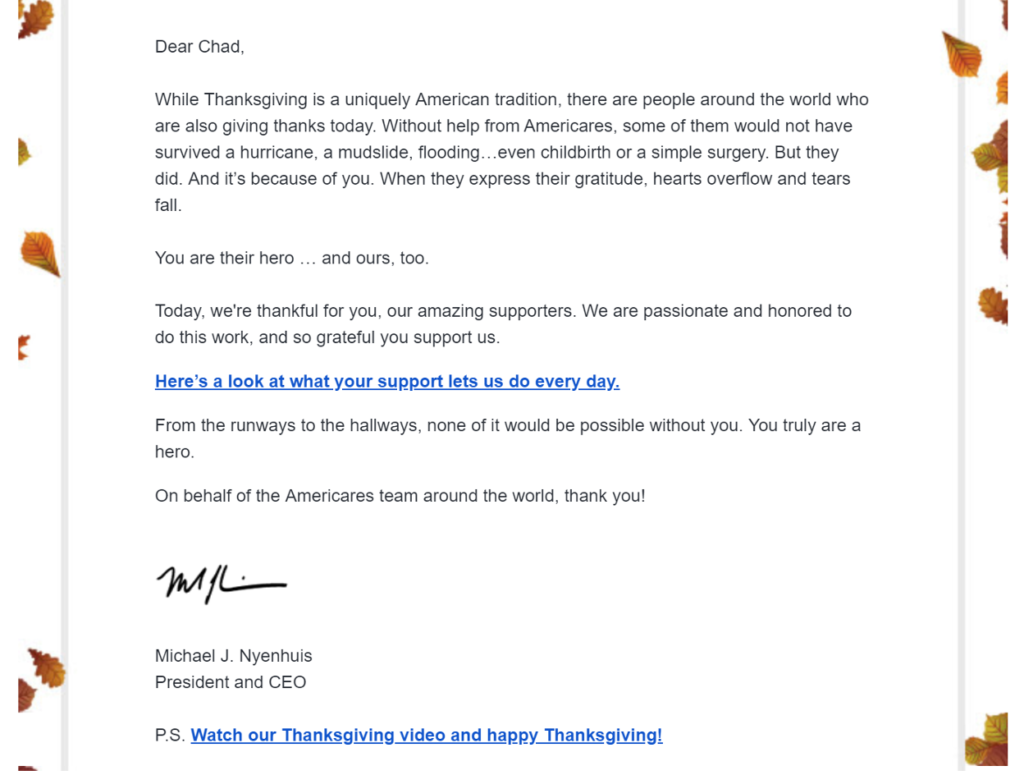
2 – The Pre-Giving Tuesday Email
Category: Donation Appeal
When to Send it: The Sunday Before Giving Tuesday
Summary: Giving Tuesday isn’t just for organizations with a massive social media following. Any organization can activate their donors and subscribers on this international giving day.
Use the “pre-Giving Tuesday” email to:
- Explain what Giving Tuesday is and why it’s important
- Explain why a donation is valuable and impactful
- Ask them to give right away
You may be tempted to ask donors to simply “mark their calendar,” but experimentation shows that this is not the most effective approach.
In fact, one nonprofit that asked their donors to “mark your calendar” for a giving day saw a 29% decrease in giving.
Never ask donors to delay their giving if they are ready to donate now — instead, invite them to make a gift now if they’re ready to give today.
3 – The Giving Tuesday Morning Email
Category: Cultivation
When to Send it: The Morning of Giving Tuesday
Summary: Giving Tuesday is all about giving. So why not give to your donors first?
Use the email on the morning of Giving Tuesday to share a free resource with your donors and subscribers. The key is gating the resource behind a form fill and sending anyone who accepts this lead magnet to an instant donation page.
Your instant donation page should act as a download confirmation and a donation page and it needs to be set up in a special way — you can get the free Instant Donation Page Template here.
Your instant donation page replaces a traditional confirmation page, and it is an essential part of a 5-step donor acquisition framework that can help you find more valuable donors online.
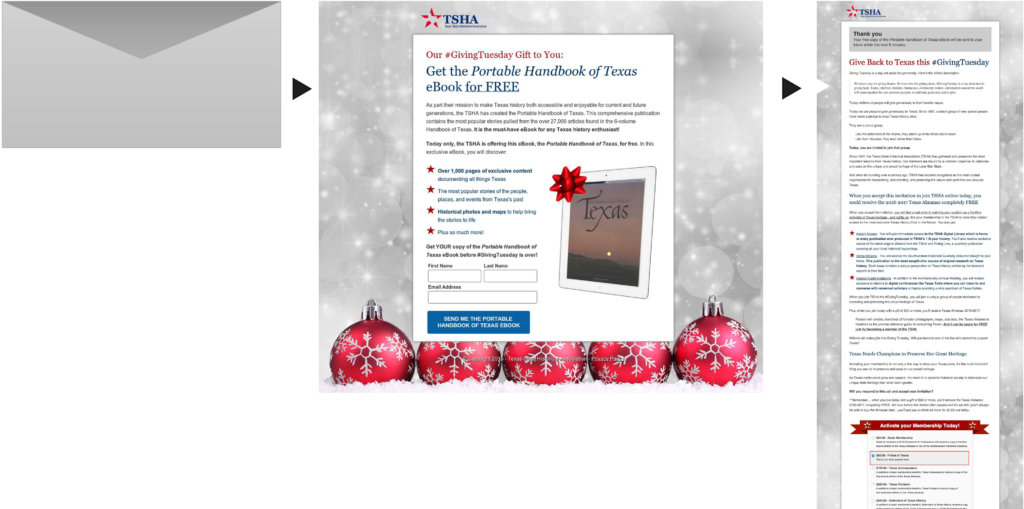
4 – The Giving Tuesday Afternoon/Evening Email
Category: Donation Appeal
When to Send it: The Afternoon of Giving Tuesday
Summary: Now that you’ve given to your donors first (using the previous email example), you can ask them directly to donate. If you have a specific matching challenge, goal, or incentive – make sure you clearly explain it in your fundraising email.
Plan to send this email out in the afternoon of Giving Tuesday – giving enough time for donors to have received your first email of the day and taken an action.
Don’t forget the basics:
- Send your email from a real person
- Call your donor by their name
- Explain why someone should give
- Give them a clear call-to-action

5 – The Year-End Overview Email
Category: Donation Appeal
When to Send it: A week after Giving Tuesday
Summary: This year-end fundraising email example is one of the most important. It’s a chance for you to clearly convey what is at stake heading into the new year. And then you can clearly ask donors to give and to make a meaningful impact.
Here’s a brief outline to follow as you write this year-end fundraising email:
- Say hello and call your donor by name
- Explain what is at stake in the new year (i.e. goals, challenges, opportunities, etc.)
- Share evidence of the impact your organization has made to help build trust
- Announce a matching opportunity, incentives, and the year-end deadline
- Clearly ask them to donate

6 – The Testimonial Pass-Along Email
Category: Donation Appeal
When to Send it: Mid-December
Summary: The testimonial pass-along email is an opportunity to share a story of impact with your donors. Rather than you telling your donors how great it is to give, you can show them just how impactful their support is with a real and compelling story.
If possible, you could even send this email from the person who has been impacted. The more you can do to build credibility and trust the better.
Finally, close this email by asking your donors to make this type of an impact with their donation.
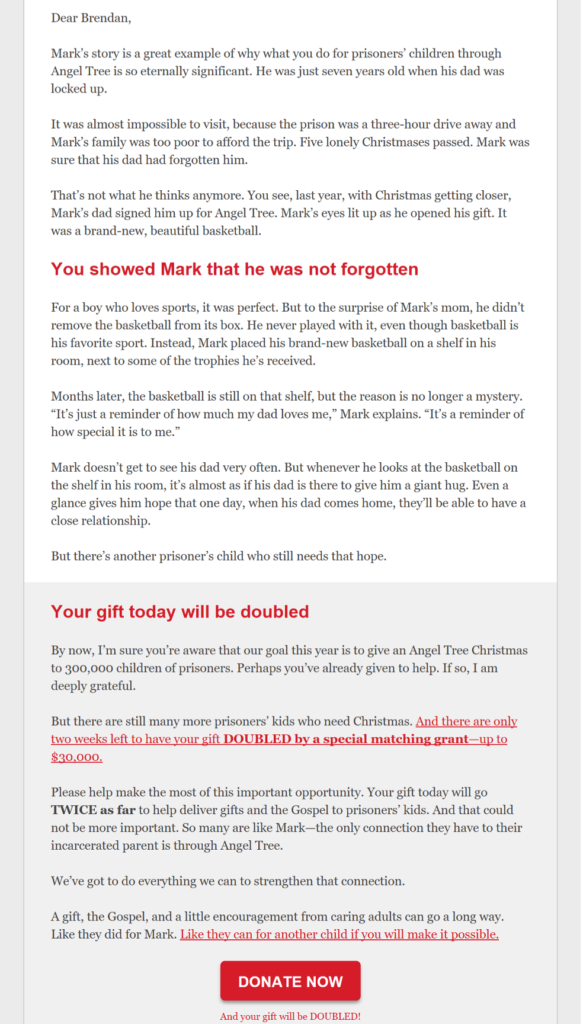
7 – The Accomplishments Email
Category: Cultivation
When to Send: Mid-December
Summary: The goal of the accomplishments email is to show donors just how much they have been able to do with their generosity. This is not about how wonderful your organization is – but rather how much impact a donation can make.
Show your donors a list of major accomplishments from the past year that have been made possible by their generosity.
Thank your donors for all they have done to make these accomplishments possible. Give them the credit!
And finally, do not ask for money. You could put a soft donation ask in a P.S. But don’t make the donation ask the center point of the email.

8 – The December Holiday Email
Category: Cultivation
When to Send: On or near your preferred holiday (see the notes below for more detail)
Summary: Every organization will have a different approach with the December Holiday Email.
If most of you donors celebrate Hanukkah, you’ll want to send this email around Hanukkah as a way to touch base, build your relationship, and cultivate them.
If most of your donors celebrate Christmas, try sending this email on Christmas Eve or Christmas Day. And if your donors celebrate a mix of holidays, send a more generic holiday email.
Regardless of which holiday(s) you recognize in the email, this is a chance for you connect with your donors around your shared values. They may be religious and faith-based values. Or you could simply wish your donors joy and peace during a busy holiday season.
The point is this: connect with your donors without asking for money, remind them of your shared values, and wish them a happy holiday.
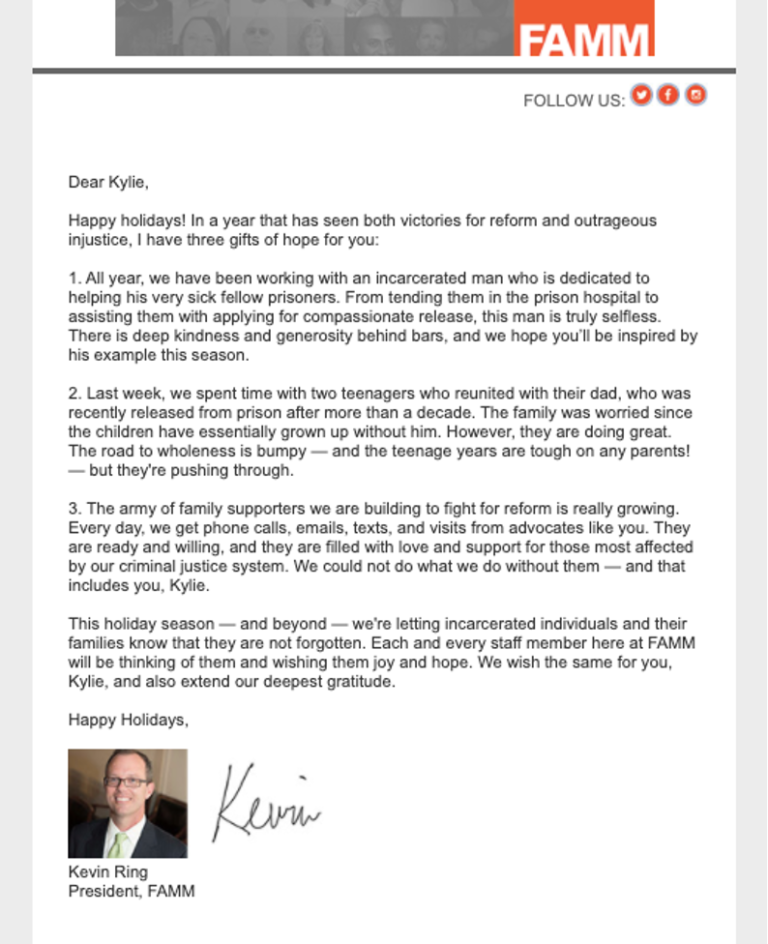
9 – The Only Days Left Email
Category: Fundraising Appeal
When to Send: Last week of the year
Summary: At last, we’ve reached the last week of the year. There are many ways to maximize donations during the last week of the year — and they all revolve around creating urgency.
Ideally, you’ve been explaining why a donation is critical and impactful all season long. The last week of the year is the time to remind donors of the deadline and incentivize them to give now.
Use the email to recap and summarize the most important challenges and opportunities at stake in the year ahead.
Commit to tackling these challenges and making an important impact. And then clearly ask your donors to give, reminding them of the deadline.

10 – The December 30th Email
Category: Fundraising Appeal
When to Send: Morning of December 30th
Summary: Time is running out to give. Remind your donors of this on the morning of December 30th. If you have any new incentives, now is the time to let your donors know.
Can their gift be doubled if they give today? How about tripled?
Has a generous donor offered to cover all overhead costs so their gift can go straight to the cause?
Maybe there’s even a free resource, tool, or special gift your donor can receive if they give before the deadline.
Whatever your best, new incentive is – now is the time to let your donors know and ask them to give before the deadline.
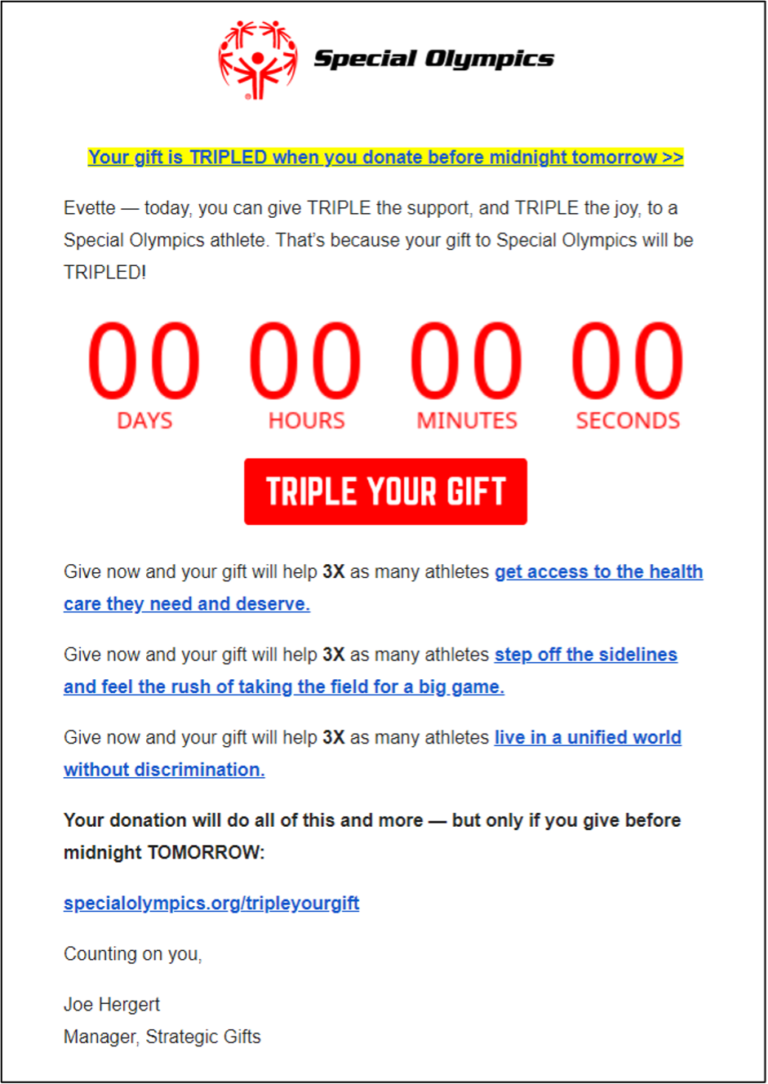
11 – The December 31st Morning Email
Category: Fundraising Appeal
When to Send: Morning of December 31st
Summary: By the time December 31st comes around, you’re just about out of time to fully explain why someone should give.
Keep this email short and to the point. Remind donors of the deadline. Show them how close they are to helping reach your fundraising goal. Urgency is the name of the game with this year-end fundraising email.
And don’t forget to clearly ask for a donation. Don’t say “Stand with us” or “Give hope.” Instead, say “You can make your donation here: [INSERT URL]”
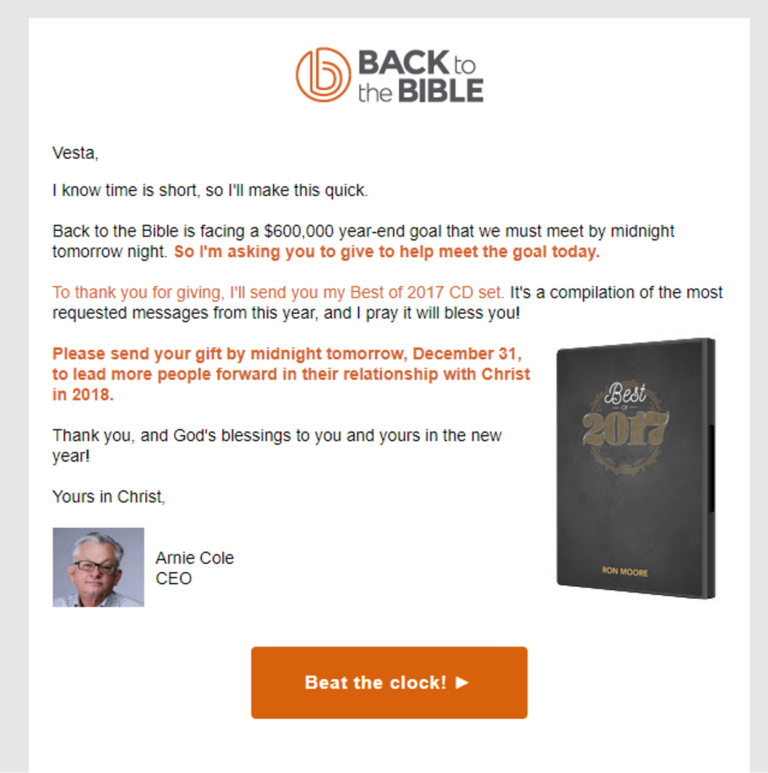
12 – The December 31st Evening Email
Category: Fundraising Appeal
When to Send: Evening of December 31st
Summary: Let’s assume the best of our donors with this email: they likely intended to give, but something came up and they haven’t had a chance yet.
Use this email as a simple reminder of the deadline. In fact, you may set it up to look like a forwarded version of the email you sent in the morning – just like a reminder email you might receive from a colleague.
Say something human and authentic like:
“Hi [First Name], Wanted to check-in to see if you got my email this morning. Will you consider giving before midnight tonight in order help [insert impact here].
You can make your donation before the deadline here: [INSERT URL]”

Bonus Email – The Thank You Email
Category: Cultivation
When to Send: First week of the new year
Summary: After you’ve crushed your fundraising goal by using all these year-end fundraising email examples, don’t forget to reach back out to your donors and thank them.
Don’t ask for an additional donation. Just briefly let donors know the impact their gift is going to make this year and thank them for their generosity and support.
These 12 fundraising emails should give you a very strong foundation for planning a successful year-end email fundraising campaign.
- The Thanksgiving Email
- The Pre-Giving Tuesday Email
- The Giving Tuesday Morning Email
- The Giving Tuesday Afternoon/Evening Email
- The Year-End Overview Email
- The Testimonial Pass-Along Email
- The Accomplishments Email
- The December Holiday Email
- The Only Days Left Email
- The December 30th Email
- The December 31st Morning Email
- 12 – The December 31st Evening Email (last chance)
These emails will help keep your organization top of mind during the busy year-end fundraising season when standing out is more important than ever.
If you want more help, click here to get your free Year-End Fundraising Campaign Timeline.



